We usually don't realize just how much stress we are under until years later, when our hips let us know. More than just a source of physical strain, tight hips can store unexpressed emotions and tension.
Follow along with these 14 hip-opening stretches to alleviate discomfort and facilitate the release of emotional burdens. Along the way, learn about why the hips get so dang tight and how to keep them loose and limber, with insights from a personal trainer and a release therapist specializing in emotional trauma.
The need-to-knows:
- Most people have tight hips: If you lead a sedentary lifestyle, have muscular imbalances, or hold emotional stress and unresolved trauma, chances are your hips are tight.
- Stretching the hips can release stored emotions: Emerging research on the mind-body connection suggests that the hips can store difficult emotions, making hip-opening stretches a mental release, too.
- Ease into hip-opening stretches: Start with our beginner stretches to nurture your hip mobility and build a foundation of trust and safety before moving onto more intense moves.
What does it really mean to “open” the hips?
Your hip flexors, aka those muscles right below your hip bones, play an important role in how you move. This muscle group includes the iliopsoas (composed of the psoas major and iliacus muscles), the rectus femoris (part of the quadriceps), and the sartorius. By lifting the knees and bending the waist, our hips make it possible for us to walk, run, and stand from a seated position.
Because the hip flexors play such a (quite literal) central role in movement, when they become tight or weakened, other parts of the body can get restricted.
“Tight or weak hip flexors can lead to a host of problems,” says personal trainer Jason Williams, NASM-CPT. “I always say, if you have tight hips, you have a tight back, which is a problem that affects most people.” In addition to lower back pain and posture issues, tight hips can limit lower body movement.
"Opening the hips" is a way to enhance hip muscle flexibility and strength—both of which are essential to movement, says Williams. To do it, you'll need targeted exercises that address the hip flexors and surrounding muscles. (We've got 14 below!)
Addressing hip tightness and immobility isn't just about physical comfort; it can also be a way to release stuck emotions. “Hips can store emotions, much like the root chakra of your body, responsible for making you feel stable and secure,” says Williams. “I’ve had students get emotional while foam rolling their hip flexors in class, which can mean they’re holding some unmet emotion."
Summary
What causes tight hips?
- A sedentary lifestyle: Prolonged sitting leads to the shortening and tightening of the hip flexors1. If you’re seated for an extended period, these muscles become contracted, reducing their flexibility over time.
- Repetitive motion activities: Activities that involve repetitive movements, such as running or cycling, can cause certain hip muscles to become overused. This overuse can lead to muscle imbalances and tightness in large muscles like the hamstrings, particularly if stretching and cross-training are neglected.
- Lack of stretching: Not stretching enough can lead to decreased hip flexibility. In addition to keeping hip flexors and surrounding muscles supple, stretching helps to maintain their flexibility.
- Poor posture: Hip tightness can also stem from poor posture2. “An anterior pelvic tilt, where the pelvis tips forward and the lower back arches, can really stretch and pull on the muscles at the front of your hips,” says Williams.
- Overuse and injuries: Overusing the hip muscles without adequate rest and recovery can lead to tightness and pain. Additionally, previous injuries to the hip or lower back area can cause compensatory movements that lead to tight hips.
- Emotional stress: The concept that the body stores emotional stress in physical form is widely acknowledged in yoga and holistic health circles. The hips are often considered a storage area for emotional tension that leads to physical tightness.
- Strength imbalances: When there is an imbalance in strength between the various muscle groups around the hips, it can lead to tightness. For example, weak abdominal muscles can increase the strain on hip flexors and lead to tightness3.
- Age-related changes: Bones are living tissues, and as we age, bones and joints naturally lose some flexibility4, leading to increased stiffness.
- Inactivity: Lack of regular physical activity can contribute to muscle stiffness and weakness. Keeping active helps maintain muscle flexibility and strength throughout the body, including in the hips.
- Improper exercise techniques: Engaging in exercises with improper form can strain the hip muscles and lead to tightness.
Hip opening stretches for beginners
Ready to open up those hips? Start with these more gentle moves to build a solid foundation before moving on to the intermediate and advanced stretches.
Butterfly Stretch (Baddha Konasana)
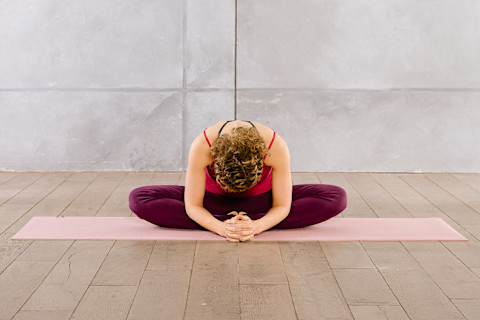
Why It Works: This gentle stretch opens the inner thighs, groin, and hips, promoting flexibility and easing tightness in the lower body.
How-To: Sit with the soles of your feet together, knees bent out to sides. Hold your feet with your hands and gently press your knees down towards the floor. Lean forward slightly for a deeper stretch.
Duration: Hold for 1-2 minutes.
Figure 4 Stretch
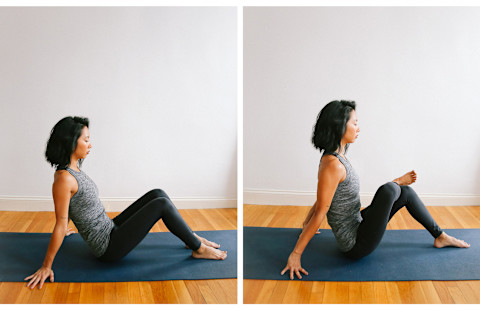
Why It Works: William recommends the figure 4 stretch for someone who feels more comfortable laying while stretching, and who might have limited flexibility but still want to work on stretching their glutes.
How-To: Lay on your back or sit with your arms behind your back. Bring your right ankle over your left thigh/knee. Pull the left leg in towards you. Hold or rock from side to side for 30 seconds. Switch legs.
Duration: Hold each side for 30 seconds.
Modified Pigeon Pose (Kapotasana)
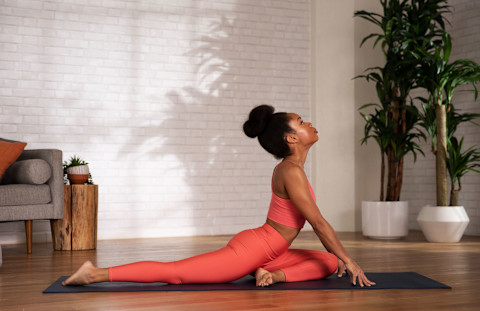
Why It Works: Pigeon pose targets the hip flexors, glutes, and lower back, aiding in the release of tension and improving hip mobility.
How-To: Start in a tabletop position, then slide one knee forward towards your hand. Extend the opposite leg behind you, keeping your hips square to the ground. Stay upright for this modified version.
Duration: Hold for 1-2 minutes on each side.
Seated Hip Stretch
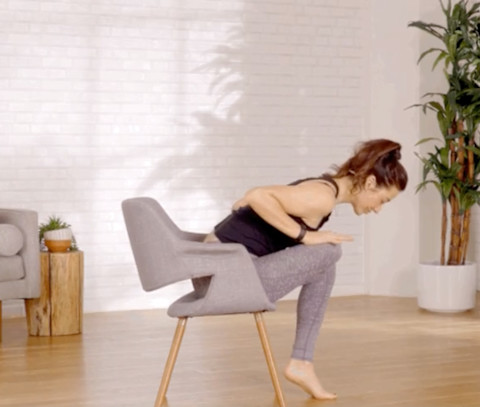
Why It Works: This stretch specifically targets the outer hip muscles, relieving tightness and improving range of motion.
How-To: Sit on a chair and cross one ankle over the opposite knee. Keep your spine straight as you lean forward, increasing the stretch in your hip.
Duration: Hold for 30-60 seconds on each side.
Nighttime Goddess Stretch
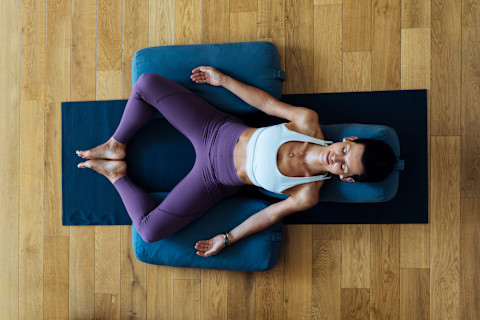
Why It Works: This stretch is convenient to do in bed, helping you relax and sleep better, explains Liza Egbogah BSc, DC, DOMP manual osteopath and myofascial release therapist.
How-To: Lie on your back with knees bent. Place the soles of your feet together, then let your knees fall open, forming a diamond shape with your legs. Use your hands to gently push your knees down towards the ground. If you feel any strain, elevate your legs by placing a pillow underneath each knee.
Duration: Hold for 30 seconds each side.
Intermediate Stretches
Lizard Pose (Utthan Pristhasana)
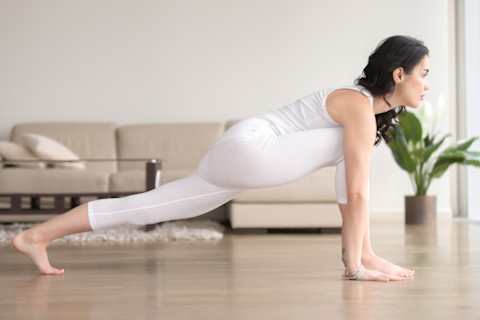
Why It Works: Lizard pose deepens the stretch in the hip flexors and quadriceps, enhancing flexibility and strength in the pelvic region.
How-To: From a plank position, step one foot outside your hand, keeping your back leg straight.
Duration: Hold for 1-2 minutes on each side.
Tree Pose (Vrksasana)
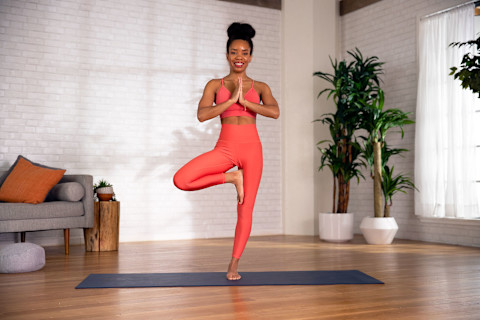
Why It Works: This balancing pose helps open the hips while also strengthening the thighs, calves, ankles, and spine. It encourages better posture and balance through the gentle opening of the hips.
How-To: Stand tall and shift your weight onto one foot. Place the sole of the other foot on your inner thigh or calf (avoid the knee), toes pointing downward. Bring your palms together in front of your heart or raise your arms overhead, keeping your gaze fixed on a point for balance.
Duration: Hold for 30 seconds to 1 minute on each side.
Cow Face Pose (Gomukhasana)
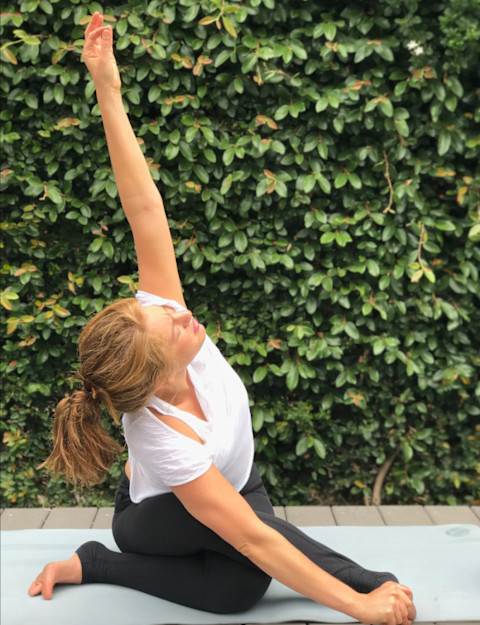
Why It Works: Cow face pose stretches the hips, thighs, and ankles while releasing tension in the lower back.
How-To: Sit with your knees stacked, one on top of the other, feet by your sides. Lean forward to intensify the stretch in your hips.
Duration: Hold for 1-2 minutes.
Half-Frog Pose (Ardha Bhekasana)
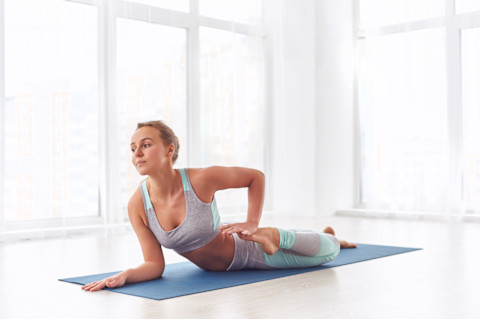
Why It Works: Half-frog pose targets the inner thighs, groin, and hips, promoting flexibility and relief from tightness.
How-To: Lie on your stomach, propping yourself up on your elbows. Bend one knee and bring it towards the same-side shoulder, keeping the other leg straight.
Duration: Hold for 1-2 minutes on each side.
Happy Baby Pose (Ananda Balasana)
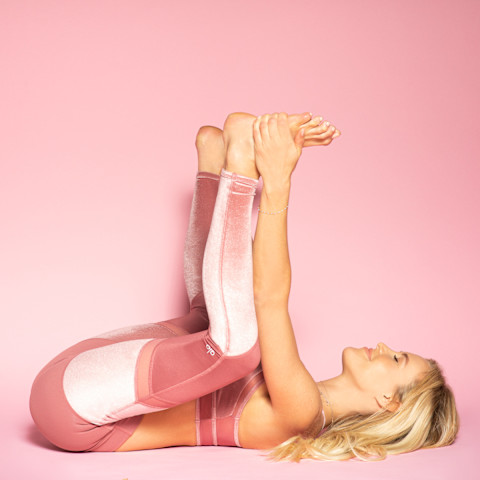
Why It Works: Happy baby pose stretches the hips, inner thighs, and lower back, promoting relaxation and stress relief.
How-To: Lie on your back. Bring your knees towards your chest. Grab the outside edges of your feet with your hands, opening your knees wider than your torso. Gently pull your knees towards the ground, keeping your back pressed to the floor.
Duration: Hold for 1-2 minutes.
Advanced Stretches
Full Pigeon Pose (Kapotasana)
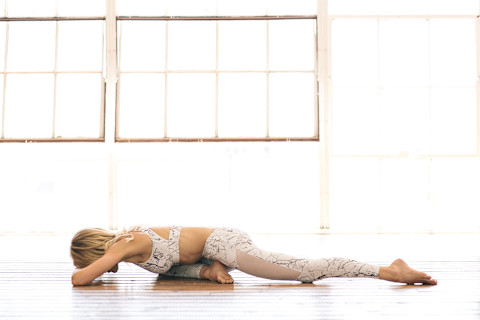
Why It Works: Full pigeon intensely stretches the hip flexors, glutes, and lower back, enhancing flexibility and relieving tension.
How-To: From a downward-facing dog, bring one knee forward to your wrist, extend the other leg back. Lower your hips to the ground and lean forward for a deep stretch.
Duration: Hold for 2-3 minutes on each side.
Frog Pose (Mandukasana)

Why It Works: Frog pose opens up the inner thighs and groin area significantly, promoting flexibility and easing tension.
How-To: Start on all fours, gradually widen your knees until you feel a deep stretch. Keep your ankles in line with your knees, lower down to your forearms.
Duration: Hold for 2-3 minutes.
Advanced Lizard Pose
Why It Works: This version of lizard pose deepens the stretch in the hip flexors and quadriceps, offering an intense flexibility workout.
How-To: From a lizard pose, bend the back knee and reach back with the opposite hand to deepen the stretch.
Duration: Hold for 1-2 minutes on each side.
Yoga Squat (Malasana)
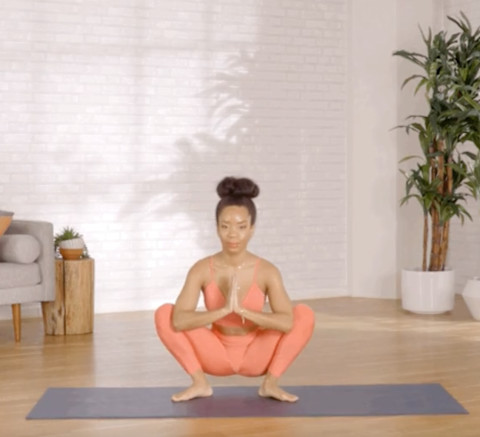
Why It Works: The yoga squat the hips, groin, and lower back, improving flexibility and aiding in digestive health.
How-To: Stand with feet wider than hip-width apart, toes pointing out. Lower into a deep squat, bringing your palms together in front of your chest. Use your elbows to gently press your knees out.
Duration: Hold for 1-2 minutes.
When to do hip opening stretches
Hip opening stretches can be beneficial at almost any time, but here are a few specific moments when they can be particularly effective:
- Before strength training: Loosening up the hips before your next leg day can enhance your range of motion, making your workouts more effective and reducing the risk of injury. A few minutes of hip stretches can prepare your body for the demands of lifting weights, especially exercises that involve the lower body like squats and deadlifts.
- After long periods of sitting: If your day involves prolonged sitting, be it at a desk or during a long drive, your hip flexors can become tight and shortened. Stretching your hips after sitting can help counteract this stiffness and maintain hip flexibility, preventing discomfort and mobility issues.
- As a post-workout cool down: After a workout, your muscles are warm and more pliable, making it an ideal time to stretch. Incorporating hip-opening stretches into your cool-down routine can aid in recovery, decrease muscle soreness, and enhance overall flexibility.
- During a yoga practice: Naturally, hip opening stretches are a fundamental part of many yoga practices. Including these stretches in your yoga routine can help balance and complement the other elements of your practice, whether you're focusing on strength, flexibility, or mindfulness.
Why do hips store emotions?
The concept that hips can store emotions is fascinating. While scientific research on the direct correlation between specific emotions and physical locations5 in the body is still evolving, there's growing recognition that mind-body connections definitely exist.
According to Egbogah, the fascia around the hip flexor muscles6 tends to store a significant amount of our emotional stress and trauma because of its high nerve innervation. “The hip flexor fascia is also connected to our abdominal fascia, so if you consider how our mental health affects our digestion (for example, stomach pain when you’re anxious), then it makes sense that this area would store our emotions,” she explains.
Many yogis also hold the belief that the hips are an area where we store deep-seated emotions, such as fear, anxiety, and trauma. Some say it's due to the hip's centralized location. Because your psoas major (which makes up your hip flexor) sits next to your adrenal glands, which produce the stress response7 in your body, your psoas muscle may respond by tightening.
“I find when we are releasing the hip flexor fascia, the emotions can vary from sad to angry and in some cases uncontrollable laughter, depending on what the patient has stored there,” adds Egbogah.
Hip opening vs. hip strengthening
Hip strengthening and hip opening exercises can overlap, but there are a few differences. “Hip opening focuses on mobility while hip strengthening focuses on making the muscles around the joint stronger and more stable,” says Williams.
Think of hip opening exercises like stretching. They help your hips move better and stop them from feeling too tight, allowing you to move around more easily and stand straighter.
Making your hips stronger, on the other hand, is like building up the muscles around your hips so they can do a good job holding everything in place.
You may need to focus on hip strengthening if you experience chronic hip or lower back pain, noticeable imbalances or weaknesses while walking, running, or standing on one foot, or difficulty climbing stairs.
You don't have to choose between stretching or strengthening your hips—it's best to do both, and getting guidance from a professional trainer can really help.
Summary
The mindbodygreen POV
In an increasingly sedentary and stressed society, hip-opening stretches can be extremely helpful. Doing a few of the aforementioned moves after sitting for long periods, before strength training, or whenever you feel tension or strain in the hip region is a great way to support your entire lower body. Emerging research on the mind-body connection suggests that the hips can store difficult emotions, making hip-opening stretches a mental release, too.
—Emma Loewe, mindbodygreen health & sustainability director
When to avoid hip openers
Most people can perform hip openers to some degree, but you should be aware of your limits if you have certain health conditions.
“If you have a severe form of hip arthritis, your hips will have limited mobility, and pushing your hips to open more than they are physically capable of can lead to injury,” says Egbogah. Any form of recent injury to the hips should be monitored by a professional.
Additionally, Egbogah cautions those with intense unresolved traumas or stressors might not want to do hip openers by themselves. “In this case, you should not be practicing hip openers without the direction of a healthcare practitioner,” she says.
Frequently Asked Questions
How do you open your hips for emotional release?
To open your hips for emotional release, combining physical poses with mindful breathing is key, a practice often rooted in yoga. You can start with some of the hip-opening poses on our list such as Butterfly Stretch, Pigeon Pose, or Cow Face. As you ease into these poses, focus on taking deep, slow breaths to help relax both your body and mind. During this process, yoga teaches to pay attention to any emotions that arise, and to let them go through exhalation.
How long does it take to open hips?
“Given how much time we spend sitting, we should be spending at least 15 minutes a day opening our hips,” says Egbogah. Within a few weeks to a couple of months of consistent practice, you should start to notice improvements in hip mobility.
What is hip opening good for?
Besides improving your mobility, boosting blood flow, and reducing back pain, opening your hips can also help you feel emotionally lighter. In yoga, it's believed that our hips hold onto tough emotions and stress, especially the kind that comes from trying to control everything in our lives. So, when you work on opening your hips, you might also let go of some of those heavy feelings.
The takeaway
Our hips are pivotal to movement and intricately connected to our emotional state. Often, stiffness in our hips can stem from prolonged sitting or subconsciously clinging to stress and challenging emotions. By engaging in stretches aimed at loosening your hips, you'll not only enhance your physical mobility but also release some of the mental strain you may be carrying.
7 Sources
- https://www.sciencedirect.com/science/article/abs/pii/S2468781220305877
- https://pubmed.ncbi.nlm.nih.gov/33188982/
- https://pubmed.ncbi.nlm.nih.gov/32669487/
- https://www.ncbi.nlm.nih.gov/pmc/articles/PMC6261527/
- https://psycnet.apa.org/record/2019-35651-001
- https://www.nature.com/articles/s41598-021-92194-z
- https://www.sciencedirect.com/topics/psychology/cortisol
